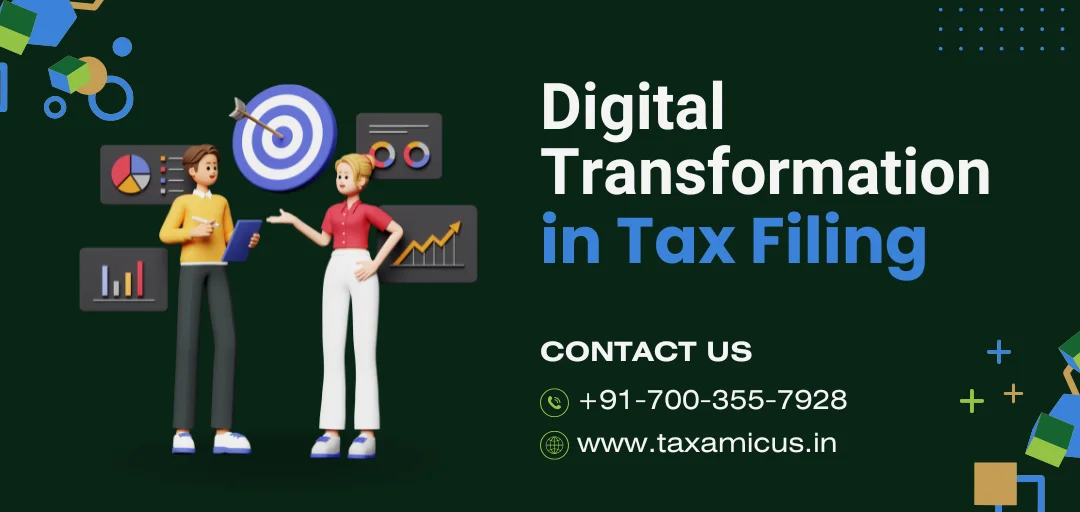Digital Transformation in Tax Filings
Digital transformation is reshaping industries worldwide, and the realm of tax filings is no exception. The adoption of advanced technology has revolutionized how taxpayers and authorities handle taxation processes, enhancing accuracy, efficiency, and transparency. Here’s an in-depth look at digital transformation in tax filings, its benefits, challenges, and what the future holds.
1. What is Digital Transformation in Tax Filings?
Digital transformation in tax filings refers to the integration of digital tools, technologies, and platforms into the tax filing process. It automates traditional manual methods, leveraging software, AI, and cloud systems to ensure seamless tax compliance. From income tax e-filing portals to Goods and Services Tax (GST) systems like GSTR filings in India, this transformation is revolutionizing the way taxpayers engage with tax authorities.
2. Key Drivers of Digital Transformation
The shift toward digitization in tax filings has been driven by several factors:
- Increased Complexity in Tax Laws: Advanced software helps manage and interpret complex tax regulations.
- Government Initiatives: Policies like India’s Digital India and global moves toward e-invoicing and real-time reporting encourage digital adoption.
- Technological Advancements: The rise of Artificial Intelligence (AI) and Machine Learning (ML) simplifies tax audits and predictive analytics.
- Demand for Transparency: Digitization ensures better transparency between taxpayers and authorities.
3. Advantages of Digital Transformation in Tax Filings
a. Enhanced Accuracy and Efficiency
By automating calculations and reducing human errors, digital tools ensure accurate tax filing. Taxpayers no longer need to worry about miscalculations, and authorities can process returns faster.
b. Time-Saving
Filing taxes digitally eliminates the need for physical paperwork and in-person visits to tax offices. Tasks that once took days can now be completed in minutes.
c. Real-Time Access and Updates
Digital tax systems provide real-time updates on tax policies and notifications. Taxpayers can access their tax records and filings at any time, ensuring compliance with the latest regulations.
d. Cost Reduction
Though initial implementation may be costly, long-term savings are substantial as digital systems streamline operations and reduce dependency on manual labor.
e. Sustainability
Going digital minimizes the environmental impact by reducing the use of paper, aligning tax systems with sustainability goals.
4. Digital Transformation in Tax Filings: The Global Perspective
Globally, countries are adopting digital transformation in tax filings with various innovations:
- India: Introduction of GSTN (Goods and Services Tax Network) for filing GST returns, e-invoicing, and e-way bills.
- USA: IRS offers robust e-filing systems and real-time tracking for taxpayers.
- Europe: Implementation of real-time VAT reporting systems in countries like Spain and Hungary.
Each country’s model demonstrates the diverse applications of digital transformation in tax filings, ensuring tailored solutions for unique taxation systems.
5. Challenges in Digital Transformation
a. Adoption and Training
Not all taxpayers are tech-savvy. Bridging the digital divide with adequate training is essential.
b. Cybersecurity Risks
As tax systems go online, protecting sensitive data from breaches becomes crucial.
c. Initial Implementation Costs
While cost-efficient in the long run, setting up digital tax systems can be expensive for governments and businesses.
d. Connectivity Issues
In developing countries, internet access and reliability can pose barriers to digitization.
6. Future Trends in Digital Tax Filings
a. AI-Powered Tax Analysis
AI will play a larger role in predictive tax analysis, identifying discrepancies before they occur.
b. Blockchain in Taxation
Blockchain technology offers secure, tamper-proof records for tax filings, increasing trust and efficiency.
c. Global Tax Harmonization
Digital transformation enables better alignment of international tax laws, reducing cross-border compliance issues.
7. How to Embrace Digital Tax Filings as an Individual or Business
- Choose the Right Software: Opt for government-recommended tools or trusted third-party platforms.
- Understand Compliance Needs: Stay updated on tax regulations and filing deadlines.
- Secure Your Data: Use strong passwords and encryption to protect sensitive information.
- Seek Help When Needed: While the goal is self-reliance, professionals can guide you through initial stages.
Conclusion
The digital transformation in tax filings is no longer a choice; it’s a necessity. By embracing these advancements, taxpayers and authorities alike can enjoy a more streamlined, efficient, and transparent taxation process. As technologies evolve, the future of tax filing looks set to become even more innovative and user-friendly.
Whether you’re a business or an individual taxpayer, staying updated and adapting to these digital tools will ensure seamless compliance and reduced tax-related stress.
Our GST Services

All E-commerce Tax services
E-commerce tax services help online sellers navigate GST registration, compliance, return filing, TCS management, tax planning, and audits, ensuring efficient tax management and legal compliance.

GST Filing
GST filing is the process of submitting tax returns to the government, detailing sales, purchases, and taxes paid or collected, ensuring compliance with GST laws.

GST Registration
GST registration is the process where businesses obtain a GSTIN from the government, allowing them to collect taxes, claim input tax credits, and comply with GST laws.





